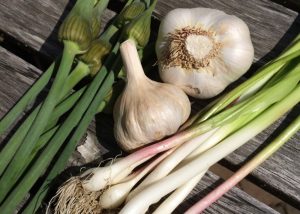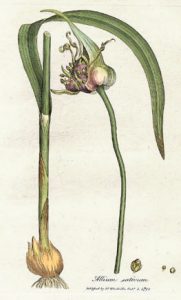 “Pat, I’d like to solve the puzzle! Green Garlic – Garlic Scapes!” You’re welcome, Wheel of Fortune.
“Pat, I’d like to solve the puzzle! Green Garlic – Garlic Scapes!” You’re welcome, Wheel of Fortune.
I loved watching Wheel of Fortune as a kid (I had a thing for word games and puzzles), and I became truly giddy just now because green garlic and garlic scapes are a true “Before & After.” Green garlic is young garlic that is harvested in later winter / early spring before the bulb has started to grow, while the leaves are still tender and the stalk is more similar to a thin leek. In fact, green garlic is probably at your local Co-op or locally-sourcing food store right now, so I highly suggest getting it before it goes out of season. Garlic scapes, on the other hand, are the bright-green curly stem and seed pod/flower that appear on a more-mature garlic plant after it is no longer green garlic. Scapes typically appear in spring and early-summer and are trimmed off before the pods open. Trimming the scapes allows for two things to happen, 1) you get to enjoy the tender stems before they get too woody and are inedible, and 2) by removing the scapes you reduce the drain on the garlic’s nutrients and allow the garlic to better mature before being harvested and hardened. I love garlic, so for me, the more ways you can use its various forms the better.
So let’s get down to all of the great ways you can prepare green garlic and garlic scapes, and also see how they can be used instead of hard garlic for a more mild flavor in many recipes.
Did you know…
Green garlic is just baby garlic (think veal) and is typically harvested when farms are thinning out their rows of garlic, though many farms plant garlic specifically to harvest it as green garlic. One downside is that green garlic does not keep as well as dried garlic bulbs, just as scallions don’t keep as long as onions. Garlic scapes, on the other hand, are the curling stem and flowering bud of hardneck garlic and are essentially a waste product. Scapes curl upward and typically form anywhere from 1 to 3 loops, resembling a pig’s tail.
Nutrition Information
Garlic scapes and green garlic are high in dietary fiber and have good amounts of vitamin C and pro-vitamin A. Both are also good sources of dietary minerals manganese and phosphorous and a moderate source of certain B vitamins, including thiamin and pantothenic acid, as well as the dietary minerals, calcium, iron, and zinc
Buying and Storing Green Garlic & Garlic Scapes
Green garlic has a long green top that looks a bit like scallions, sometimes a tiny bulb at the end, and it may even be tinged with a bit of pink on the outer layers. You may have actually seen it in the store before and thought that it was scallions. Because green garlic looks so similar to scallions, when buying green garlic, it is best to follow the same rules as choosing leeks or scallions. Look for green garlic with leaves that haven’t started to shrivel, a little wilted is fine, but unless you’re just tossing them in stock you want the greens to look fresh. Because when they look fresh, more than likely they will taste fresh. Avoid stems that have major damage (though you can always cut bad sections out) and make sure your stalks haven’t started to get mushy.
Storing green garlic is very similar to storing scallions. Wrap them in a damp paper towel and place in a ziplock bag in the refrigerator. They will last about 5-7 days like this. They can also be left out for a short period of time on the counter but should be left in a tall glass with water just covering the white part.
When buying garlic scapes, feel the scapes and make sure they aren’t too woody, they should feel supple and bend easily. Farmers and stores will sell them in bunches, or let you pick out your own. Whichever way you find them, always remember to check the end where the scape was cut from the plant because it will always be woodier at the base. After being cut from the garlic plant, very little preparation of the scape is needed beyond rinsing. Make sure to trim off any woody sections near the base (where the scape was cut from the pant) as they can be even more hard to gnaw through than woody asparagus.
Store scapes in a plastic bag in the refrigerator for two to three weeks. Scapes can also be left out on the counter with the stems in a glass of water. They will keep well and make a beautiful “flower” arrangement until you’re ready to use them. Make sure to change the water daily.
Garlic scapes can be used in exactly the same way as garlic in any recipe, but are even more versatile as their garlic flavor is milder, though not as mild as green garlic.
 Cooking
Cooking
Raw: both green garlic and garlic scapes are delicious and extremely versatile when used raw. You can blend them into dressings, sauces, or dips. You can use them on raw vegetable platters with dips, cut into half-inch to inch long sections and add to salads or pasta salads, or chop and sprinkle on pizza with asparagus, parmesan, and a drizzle of oil.
Grill/Roast: leave the scapes of green garlic stalks whole and toss with olive oil, salt, and pepper. Roast in the oven at 350 for 20 minutes or place them on a med-hot grill, turning occasionally, until they are slightly browned in some areas. Great as a side dish with steaks or pork chops. The garlic flavor will mellow out quite a bit and you will have a delicious side dish with just enough kick to not get lost on your plate.
Blend/puree: puree in a blender or food processor until no large chunks are left. You will have to add olive oil to the puree to get it to fully blend. Add to dressings, sauces, marinades, dips, or add some parmesan, olive oil, salt, and pepper and make a delicious garlic scape or green garlic pesto. If you want to save money and make a ton of pesto this summer, I always substitute sunflower seeds for pine nuts in my pestos. You can actually use any variety of nut when you get down to it, just do some test runs because nuts have very different flavors, and some nuts might not have the flavor profile you like with your pesto.
Sauté: slice or chop scapes or green garlic to the desired size and sauté. Add to omelets, stir-fry, quiche, frittata, or pasta.
Garlic scape and green garlic puree can be easily frozen and the scapes and stalks of green garlic can be pickled and stored long-term.
Recipes:
10 Things to do with Garlic Scapes – Bon Appetit (https://www.bonappetit.com/test-kitchen/ingredients/article/garlic-scapes)
Green Garlic – An Adolescent Allium (https://food52.com/blog/6458-green-garlic-the-adolescent-allium)
Fava Bean Dip with Goat Cheese and Green Garlic (https://www.simplyrecipes.com/recipes/fava_bean_dip_with_goat_cheese_and_garlic/)
Mini Potato Pancakes with Green Galic and chives (https://www.thekitchn.com/recipe-mini-potato-pancakes-with-green-garlic-and-chivesrecipes-from-the-kitchn-168860)
Egg, Spinach, and Spelt Salad with Green Goddess Dressing (https://www.thekitchn.com/recipe-egg-spinach-and-spelt-salad-with-green-garlic-dressing-recipes-from-the-kitchn-201697)
Radish and Turnip Hash with Fried Egg (https://www.thekitchn.com/recipe-radish-and-turnip-hash-with-fried-eggs-230586)
Bobby Flay’s Pizza Dough (https://www.epicurious.com/recipes/member/views/pizza-dough-bobby-flay-5b711de44e722a4f20884ace)


